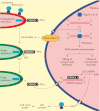How does doxorubicin work?
- PMID: 23256047
- PMCID: PMC3524826
- DOI: 10.7554/eLife.00387
How does doxorubicin work?
Abstract
A new mechanism involving cleavage of a transcription factor called CREB3L1 has been proposed to explain the anti-tumour effects of doxorubicin.
Keywords: CREB3L1; Human; cancer; ceramide; doxorubicin.
Conflict of interest statement
Figures

Comment on
-
Doxorubicin blocks proliferation of cancer cells through proteolytic activation of CREB3L1.Elife. 2012 Dec 18;1:e00090. doi: 10.7554/eLife.00090. Elife. 2012. PMID: 23256041 Free PMC article.
References
-
- Kremer LC, van Dalen EC, Offringa M, Ottenkamp J, Voute PA. 2001. Anthracycline-induced clinical heart failure in a cohort of 607 children: long-term follow-up study. J Clin Oncol 19:191–6 - PubMed
Publication types
MeSH terms
Substances
LinkOut - more resources
Full Text Sources

